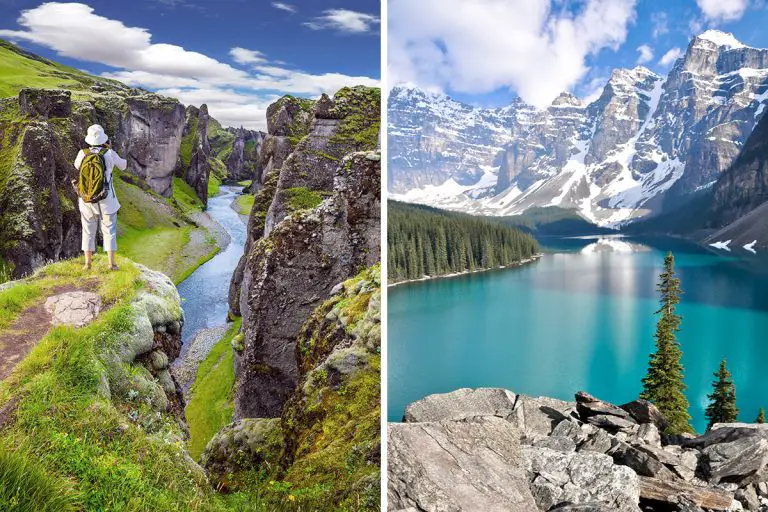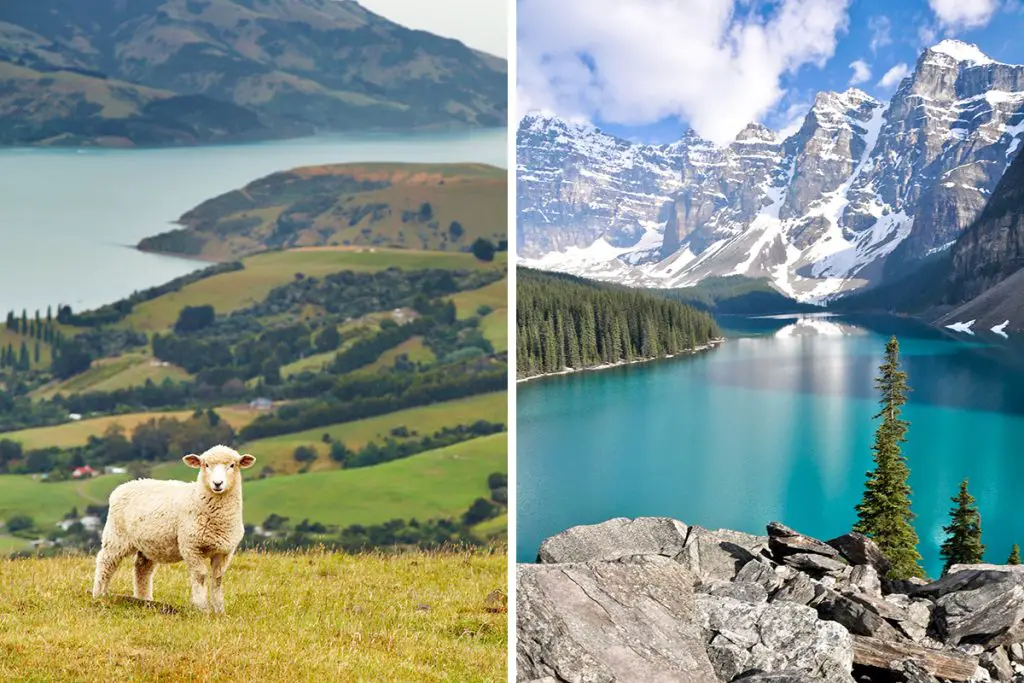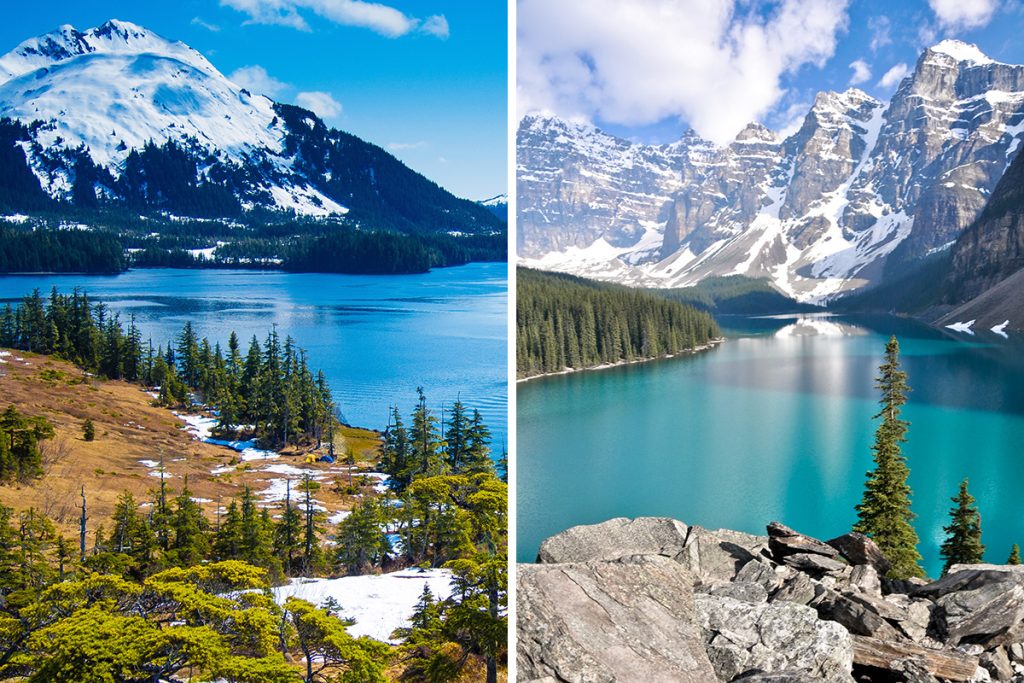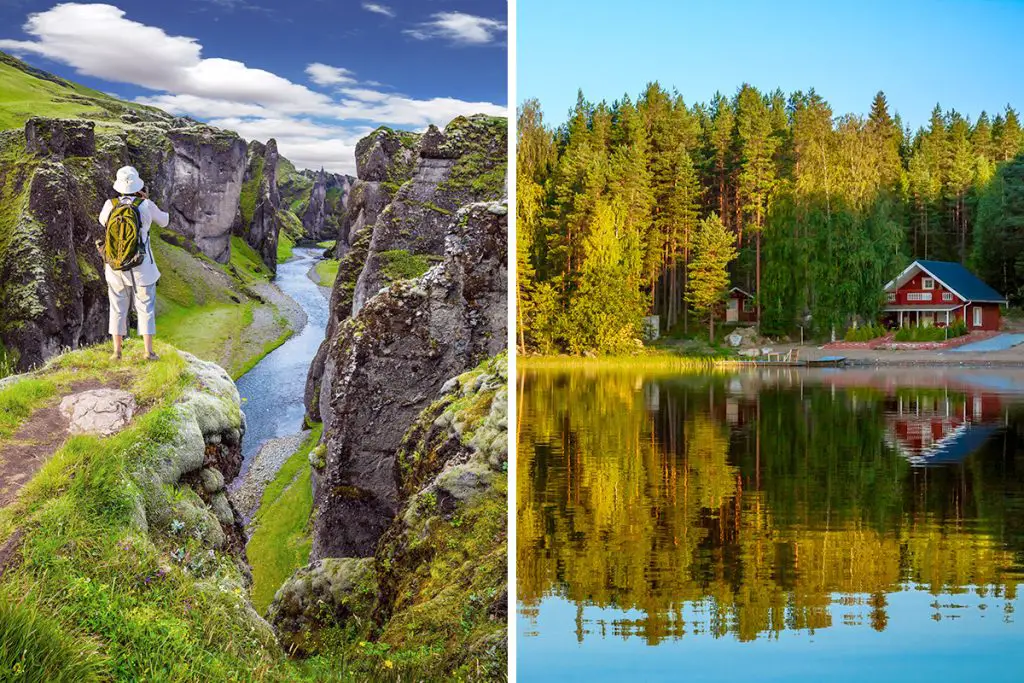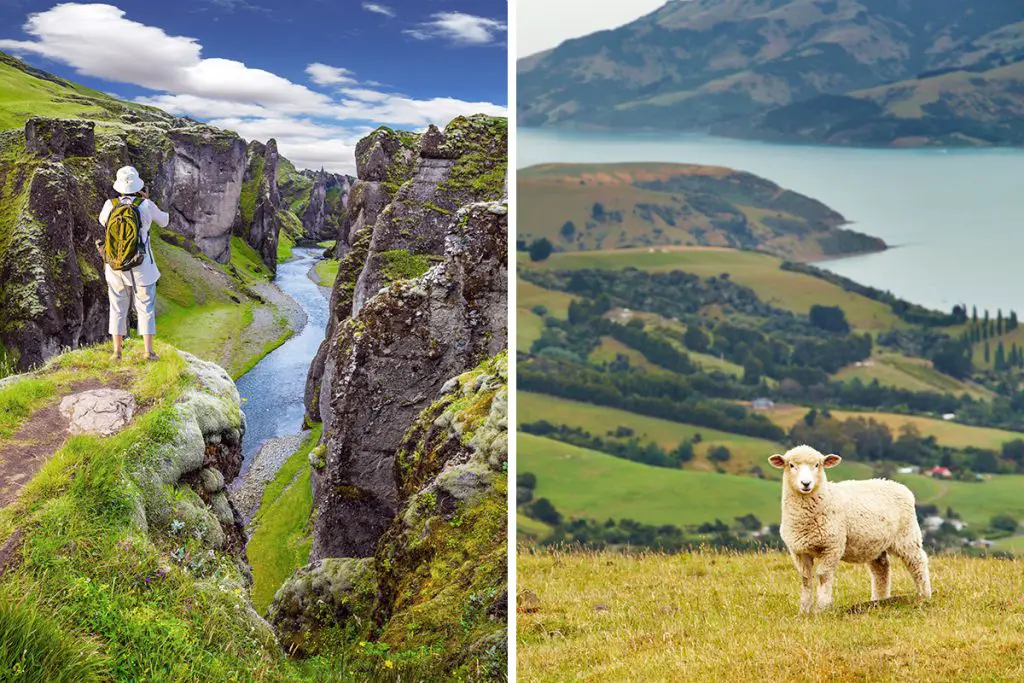Every journey starts with a decision, and deciding where to explore next is half the fun. Whether it’s the stunning land of fire and ice, Iceland, or the expansive wilderness and vibrant cities of Canada that catch your eye, the choice is sure to bring forth remarkable experiences. So why not dive in and discover what makes each of these destinations so extraordinary? Keep reading to unravel the historical and cultural tapestries of both Iceland and Canada.
History & Culture
Dipping your toes into the historical waters of Iceland and Canada, you’ll discover stories etched in time. Rich tales of Vikings, settlers, and exploration are interwoven with the threads of these nations, each unique and captivating.
In the chilly climes of Iceland, the nation’s history is tied closely to the sea. Originating from Norsemen who crossed the North Atlantic Ocean, Icelandic culture is steeped in seafaring tales and sagas.
Iceland’s early history, filled with Viking exploration and settlement, has shaped a resilient and independent culture. Literature, art, and music deeply influenced by this Viking heritage give Iceland its distinct cultural flavor.
On the flip side, Canada’s past is a tapestry of indigenous history and European settlement. Before European arrival, First Nations had already formed a rich and diverse cultural landscape. The arrival of the French and British settlers added new threads to this tapestry, intertwining to create a multicultural nation.
Canada’s culture is a colorful patchwork of languages, traditions, and beliefs, deeply rooted in this blended history.
The histories of Iceland and Canada are undeniably different, yet equally captivating. From Iceland’s sagas of sea-faring Vikings to Canada’s mosaic of indigenous and European traditions, both nations hold a wealth of historical and cultural riches.
No matter where your journey takes you, the past will serve as a captivating guide, painting a vivid picture of the lands you tread.
To summarize, whether it’s Iceland’s ancient tales of Viking exploits or Canada’s mix of indigenous and colonial history that pique your interest, both countries offer a deep dive into history and culture. The choice, as ever, rests with you: the crisp Icelandic sagas or the rich Canadian tapestry? What story will you choose to step into?
Attractions & Activities
When it comes to attractions and activities, both Iceland and Canada offer plenty to keep adventurers engrossed. From breathtaking natural wonders to engaging cultural experiences, each country presents its own unique allure. Now, let’s delve into what both Iceland and Canada have in store for you.
In Iceland, the Golden Circle route is a must for any visitor. This popular tourist trail includes three striking natural sights: Þingvellir National Park, the geysers in the Haukadalur valley, and Gullfoss waterfall. Also, an exploration of the luminous ice caves of Vatnajökull National Park during winter can make your trip to Iceland unforgettable.
For a distinct cultural activity, consider visiting one of the many geothermal pools scattered across the country, a true Icelandic pastime.
On the other hand, Canada’s diverse landscapes and cityscapes provide a wide array of attractions. The Rocky Mountains in Alberta offer endless opportunities for hiking and wildlife spotting. The picturesque Banff National Park, nestled in the heart of the Rockies, is a standout.
For those with a taste for urban exploration, the CN Tower in Toronto and Old Montreal’s cobblestone streets brimming with history shouldn’t be missed.
Comparing the two, Iceland serves up unique geological phenomena and dramatic landscapes in a compact space, ideal for those who love road trips and nature. Meanwhile, Canada’s sprawling landscapes and cosmopolitan cities cater to both nature lovers and urban explorers. Both countries provide an array of experiences that cater to varied interests and preferences.
In a nutshell, whether you’re drawn to the geothermal wonders and the Viking past of Iceland or the dynamic urban spaces and breathtaking nature of Canada, you’ll find the attractions and activities in both places offer unique experiences. The ultimate decision lies in your hands. What kind of adventure are you craving?
Eating, Drinking & Nightlife
Experiencing the food, beverages, and nightlife of a place is often an adventure in itself, offering a glimpse into the local culture. Let’s dive into the culinary scene and nightlife of Iceland and Canada, two countries with distinctive offerings.
Icelandic cuisine is deeply influenced by the island’s isolated location and harsh climate, resulting in a unique food culture. Traditional dishes like hangikjöt (smoked lamb) and skyr (a thick, yogurt-like dairy product) are must-tries. For seafood lovers, the fresh Icelandic cod and langoustine are hard to beat.
In contrast, Canadian cuisine offers a diverse palate reflecting the country’s multiculturalism. From the hearty tourtière (meat pie) of Quebec to the delectable butter tarts and poutine, there’s something for everyone. Also, the coastal regions offer sumptuous seafood including world-famous Pacific salmon and Atlantic lobsters.
When it comes to beverages, Icelanders are particularly fond of their craft beers. Microbreweries are on the rise, offering a range of unique flavors. The traditional drink, Brennivín, also known as ‘black death’, is a schnapps made from fermented potatoes and caraway.
Canada is known for its excellent range of local and craft beers, with breweries scattered across the country. It’s also renowned for ice wines, produced from grapes frozen while still on the vine, creating a sweet, concentrated wine.
Nightlife in Iceland, especially in the capital Reykjavik, is surprisingly lively. You can find a range of pubs and clubs where locals and tourists mingle, often until the early morning hours. In contrast, Canada’s nightlife is as diverse as the country itself, with lively pubs in Halifax, upscale clubs in Toronto, and laid-back bars in Vancouver.
In summary, both Iceland and Canada offer distinct eating, drinking, and nightlife experiences. Whether it’s the unique traditional dishes and lively nightlife of Iceland, or the multicultural cuisine, wide variety of drinks, and diverse nightlife of Canada, both promise unforgettable experiences. Which culinary adventure will you choose?
Shopping
When it comes to shopping, both Iceland and Canada offer unique retail experiences. Whether you’re on the hunt for memorable souvenirs or high-end fashion, these countries have something for every shopper.
In Iceland, you’ll find a mix of boutique stores and shopping centers, particularly in Reykjavik. Specialties include Icelandic wool products like the traditional lopapeysa (a type of knitted sweater), and unique handmade jewelry inspired by the country’s stunning landscapes. Also, Icelandic music records are popular collectibles.
Canada offers a range of shopping experiences from coast to coast. You’ll find high-end fashion and accessories in the shopping districts of Toronto and Vancouver. Canada is known for its local crafts, particularly First Nations art including carvings, prints, and handcrafted jewelry. Maple syrup and Canadian Ice Wine also make excellent take-home treats.
Comparing the two, Iceland offers a range of locally made products that reflect the country’s culture and landscapes. In contrast, Canada’s diverse cities and local communities provide a wide variety of shopping experiences, from high-end retail to local crafts.
In conclusion, whether it’s the charming boutiques of Iceland or the diverse shopping districts of Canada, each offers unique items that would make a perfect memento of your journey. Which shopping experience will make your suitcase a bit heavier?
Accommodation
A good place to stay is a key part of any adventure, right? So, let’s look at what types of accommodations you can expect in Iceland and Canada.
In Iceland, accommodations vary from cozy guesthouses and farms that offer an authentic taste of local life, to luxury hotels. Iceland’s capital, Reykjavik, boasts a range of boutique hotels, each with its own unique charm.
For a more immersive experience, consider staying in a cottage or a guesthouse in the countryside, where you can enjoy the breathtaking natural scenery right at your doorstep.
In contrast, Canada offers a wide array of accommodation types to suit any budget or preference. Luxury hotels, charming bed and breakfasts, and cozy cabins in the wilderness – you name it!
In cities like Toronto and Vancouver, you’ll find a plethora of high-end hotels and serviced apartments. If you’re heading into the great outdoors, consider staying in a lakeside cabin or a mountain lodge for a truly Canadian experience.
So, whether it’s the rustic charm of an Icelandic guesthouse or the diverse offerings from city luxe to wilderness coziness in Canada, you’re sure to find the perfect place to rest your head. Which country’s accommodations fit your travel style the best?
Family-Friendliness & Children’s Activities
When it comes to family-friendly destinations, both Iceland and Canada offer a wealth of experiences that kids will love. Let’s explore what each country has to offer.
In Iceland, families can enjoy a variety of outdoor activities. For instance, the Golden Circle tour, with its geysers and waterfalls, is sure to fascinate kids. Whale-watching tours are also a hit with children, offering an opportunity to see these magnificent creatures up close.
Canada, on the other hand, offers a multitude of family-friendly attractions. In the city, places like the Toronto Zoo, the Ontario Science Centre, or Vancouver’s Science World are sure to delight children. For nature-based activities, consider a trip to one of the national parks where kids can engage in activities like wildlife spotting, hiking, and canoeing.
While Iceland offers the excitement of witnessing geothermal wonders and wildlife, Canada provides a mix of both educational city attractions and exciting outdoor experiences. Each country holds the promise of unforgettable memories for your family. So, which destination will your family choose for your next great adventure?
Getting There & Getting Around
Traveling to and navigating through a new country can be part of the adventure. Let’s discuss what getting to and moving around in Iceland and Canada looks like.
To reach Iceland, you would typically fly into Keflavík International Airport, about 50 kilometers (approximately 31.1 miles) from the capital city, Reykjavik. Several airlines offer flights from various cities around the world.
To get to Canada, there are numerous international airports spread across the country including in cities like Toronto, Vancouver, Montreal, and Calgary, all serving flights from global destinations.
Getting around in Iceland is relatively straightforward with the majority of travelers opting to rent a vehicle. The country has one main highway, Route 1, also known as the Ring Road, which loops around the island, making it easy to navigate. However, keep in mind that some attractions require driving on gravel roads.
Canada, due to its massive size, presents more varied options for getting around. Internal flights are common for long-distance travel. For shorter distances, Canada has a well-established rail network. Rental cars are a good option for more flexibility, especially for exploring the national parks.
In conclusion, whether you’re navigating Iceland’s Ring Road or hopping on a train or plane in Canada, getting to and around these countries is part of the journey. Each offers its own unique travel experiences. Which adventure are you ready to embark on?
Weather
Weather can play a big role in how much you enjoy your travel adventures. Let’s take a closer look at the climate in both Iceland and Canada to help plan your journey.
Iceland experiences cool temperatures year-round. The summer months, from June to August, are the warmest with temperatures typically ranging from 50°F to 59°F (10°C to 15°C).
The winters, particularly from December to February, can be quite chilly with temperatures averaging between 27°F and 37°F (-3°C to 3°C).
Canada, on the other hand, offers more varied weather due to its large size. Summers in most parts of the country, particularly from June to August, can be quite warm with temperatures ranging from 59°F to 86°F (15°C to 30°C).
Winters, especially from December to February, can be extremely cold, particularly in the northern and interior regions, where temperatures can drop below -4°F (-20°C).
To summarize, while Iceland offers cool temperatures year-round, Canada provides a mix of warm summers and very cold winters. So, would you prefer the constant cool of Iceland or the varied seasons of Canada for your next adventure?
Safety
Feeling safe and secure is essential when traveling. Let’s compare the safety of Iceland and Canada.
Iceland is often regarded as one of the safest countries in the world, with very low crime rates. In fact, it’s so safe that sometimes locals leave their cars running while they run errands!
Canada is also considered a safe destination for travelers. While it has larger cities where crime rates may be higher, these are typically still low compared to other major cities worldwide. As always, using common sense and taking basic precautions should keep you safe.
As for natural hazards, Iceland’s landscape includes active volcanoes and geysers, so heed warnings and stay on marked paths when exploring. In Canada, wildlife encounters (particularly with bears in some regions) may be a concern, so it’s essential to know how to behave if you come across these animals.
In conclusion, both Iceland and Canada are generally safe destinations with their unique considerations. Whether it’s respecting geothermal activity in Iceland or understanding wildlife in Canada, a little knowledge goes a long way!
Cost
Budgeting is a vital part of travel planning. Let’s look at the average costs in Iceland and Canada to help you prepare.
Iceland is known for being quite pricey. The cost for a meal at an inexpensive restaurant would be around 2,500 ISK (approximately 20 USD). A night at a mid-range hotel might cost around 20,000 ISK (approximately 160 USD). Renting a compact car could be about 10,000 ISK per day (around 80 USD).
Canada, in comparison, can offer more value for your money. A meal at an inexpensive restaurant might cost around 20 CAD (approximately 16 USD). A night in a mid-range hotel could set you back around 150 CAD (around 120 USD). A compact car rental would be about 40 CAD per day (approximately 32 USD).
In summary, while Iceland may be a bit more expensive in terms of food, lodging, and transportation, Canada offers a slightly more budget-friendly option. Where will your budget take you on your next adventure?
Which Is Better – Iceland or Canada?
Choosing between Iceland and Canada can feel like a difficult task given the unique experiences each offers. But let’s reflect on what we’ve learned to help you decide.
From a historical and cultural perspective, Iceland offers an intimate view of Nordic heritage mixed with modern creativity, while Canada delivers a blend of cultural influences from its indigenous people, French, and British roots.
If you’re intrigued by Viking sagas and geothermal wonders, Iceland might be for you. But if the cultural mosaic of a vast nation draws you in, then Canada would be a fantastic choice.
When it comes to attractions and activities, Iceland’s unique geological features like geysers and glaciers stand out. On the other hand, Canada’s vastness provides a broad range of natural attractions, from the Rocky Mountains to its iconic Niagara Falls.
If the call of the wild pulls at your heartstrings, the expansive landscapes of Canada await. But if you’re after an otherworldly experience, Iceland’s unique terrain might be your perfect match.
Regarding beaches, while Iceland’s black sand beaches offer an unusual and dramatic seaside experience, Canada’s coasts boast some of the world’s longest natural sand beaches. If you’re looking for a beach experience that’s out of the ordinary, Iceland’s beaches are sure to mesmerize you. But if miles of golden sands appeal to you, then Canada’s coasts may be calling.
In the realm of eating, drinking, and nightlife, both Iceland and Canada have strong culinary scenes. But if you’re excited by innovative uses of local ingredients, Iceland’s dining scene might thrill your taste buds. On the flip side, if you enjoy a mix of global culinary influences, Canada’s diverse food scene may be your ideal choice.
When considering the cost, Iceland is generally more expensive than Canada. However, if a once-in-a-lifetime experience amid some of the world’s most unique landscapes is worth the extra spend to you, then Iceland could be your dream destination. If you’re after a more budget-friendly but equally enriching travel experience, Canada might be the better choice.
To sum it up, whether it’s Iceland with its unique Nordic charm and otherworldly landscapes, or Canada with its cultural diversity and vast natural beauty, your choice ultimately depends on what kind of adventure you’re looking for. Where will your travel story be written – among Iceland’s glaciers or Canada’s sprawling landscapes? The choice is all yours!

